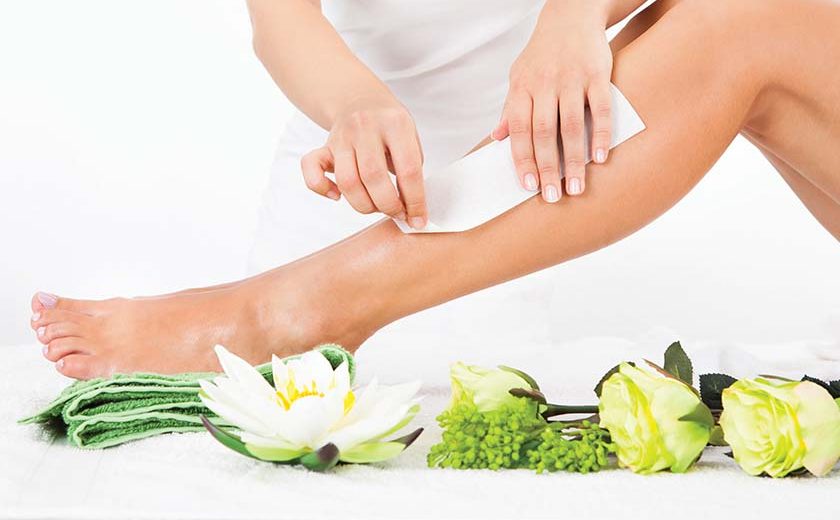Read this at-home waxing guide before attempting to wax yourself
Once you overlook the temporary pain, at-home waxing is mighty tempting. Besides saving money on countless hair removal products and salon waxing treatments, you can look forward to being stubble-free for weeks — minus the razor burn or nicks. However, at-home waxing involves more than a simple disposable razor.
While at-home waxing is convenient, there are definitely rules for the at-home hair removal life. So as to avoid ingrown hairs, burns and possible bruising, it’s important to know your waxing basics. So before you try that waxing kit you just bought, read these essential at-home waxing tips so you wind up with smooth, hair-free skin — not ingrown hairs
and frustration.
Do: Prevent Ingrown Hairs by Exfoliating and Moisturizing
Before and after waxing, regularly and gently exfoliate skin, with either a body scrub or a washcloth or bath pouf. Be sure to moisturize skin with a light lotion after, to hydrate skin and leave you extra smooth.
Don’t Wax Hair That’s Too Short or Too Long
For ideal waxing conditions, hair should be between 1/4 inch and 3/4 inch long (as if we needed another excuse to avoid shaving). Any shorter and the wax won’t be able to adhere well enough. If your hair is longer, try trimming it with safety scissors beforehand to make the waxing much less painful and efficient.
Do: Use Baby Powder Pre-Wax
For hairless (and baby smooth) skin, you’ll want this at-home waxing insurance policy. After cleansing your skin, sprinkle a bit of baby powder to the area about to be waxed. It’ll absorb any excess moisture so the wax and cloth strip can adhere properly.
Do: Test the Temperature of Your Wax
To avoid a hot mess (literally), always test your wax by applying a bit to the inside of your wrist to make sure it’s at a comfortable spreading temperature. Too cold and it won’t spread, too hot and you’ll burn yourself, ouch!
Do: Apply and Pull in the Right Direction
If you’re an at-home waxing newbie, then this next tip is especially important. Always apply wax in the direction of hair growth, as it allows the wax to adhere more fully. After spreading on the wax, place the cloth strip over the wax and press it down firmly using strokes in the same direction as hair growth. Leave the strip on for a few seconds to set.
When removing the cloth strip, hold your skin taut and quickly pull it off in the opposite direction of hair growth. Stay close and parallel to the skin, like turning a page in a book, don’t lift the strip up in the air.
Do: Apply Pressure Post Wax
Beauty is pain, but at-home waxing doesn’t have to be unbearable. Immediately after removing the cloth strip, apply pressure to the waxed area to help relieve the sting and make skin less sensitive.
Don’t: Wax the Same Area More Than Twice
Going over the same area more than twice can damage the skin — and be quite painful. If you still have a few stray hairs after applying the wax twice, use tweezers to remove them.
Do: Use Baby Oil Post-Wax
After waxing, you want to make sure you give your skin a little love. A hydrating product, like baby oil, can help clean up any residual wax on your skin, and also moisturize the skin. How’s that for killing two birds with one stone?
Don’t: Pick at Ingrown Hairs
Although it’s tempting, picking at ingrown hairs won’t help, and it may lead to an infection. If you have stubborn ingrown hairs after waxing, soak in warm water to soften the skin, gently exfoliate the area and apply a salicylic acid treatment to help further exfoliate the area. If you really must pick, only use sterilized tweezers and only do it to ingrown hairs that are right at the surface of the skin.
Don’t: Try a Brazilian Wax at Home
This style of waxing (in which all hair is removed, with the possible exception of a thin landing strip) can be difficult to do on yourself, as there are some very hard to reach places. Skip the at-home waxing, and leave the full wax to a pro.
Do: Use a Hair Growth Inhibitor
Using a product that helps minimize hair growth means you’ll eventually need to wax less often (in a perfect world). Though we’re skeptical of how well they work long term, hair inhibitors do help soften coarse hair, making it easier and less painful
to wax.
Don’t: Try Waxing Under These Conditions
If you’re taking strong acne medications (which can make skin extra-sensitive), have a sunburn or have any sort of circulation- or immune system issues, you should avoid waxing.
Also, waxing your bikini area two days before or after your period can be more painful than other times because your skin is more sensitive due to your hormones (thanks Mother Nature).
Reference:
www.totalbeauty.com


